June 17, 2014, 11:12 am | by Ray Nardo
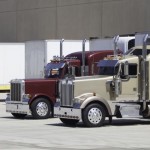 Whether you’re talking about tankers, flatbeds, or open or enclosed trailers, the business of loading and unloading, or servicing large vehicles can present a fall hazard. Working on loading docks, on scaffolding above or beside the trucks, or on the roof or sides of the trucks themselves, workers put themselves at risk in multiple situations where they are in danger of falling. Read more.
Whether you’re talking about tankers, flatbeds, or open or enclosed trailers, the business of loading and unloading, or servicing large vehicles can present a fall hazard. Working on loading docks, on scaffolding above or beside the trucks, or on the roof or sides of the trucks themselves, workers put themselves at risk in multiple situations where they are in danger of falling. Read more.
May 9, 2014, 11:06 am | by Ray Nardo
 Construction sites and demolition operations come with their own set of unique fall hazards. Putting people in serious danger and structures at risk for major damage, these scenarios have potentially costly ramifications in terms of both lives and dollars.
Construction sites and demolition operations come with their own set of unique fall hazards. Putting people in serious danger and structures at risk for major damage, these scenarios have potentially costly ramifications in terms of both lives and dollars.
Safety netting, also known as debris or personnel netting, helps to prevent fall hazards around construction sites and demolition operations. Read more.
May 2, 2014, 2:18 pm | by Ray Nardo
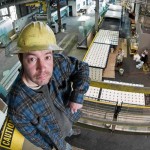 According to the Bureau of Labor Statistics, in 2012, there were 544 fall-related fatalities. Of those cases, about one in four occurred from a fall of 10 feet or fewer. This statistic suggests something rather stark: It doesn’t take a whole lot of distance for a workplace accident to be fatal. As the person responsible for safety at your factory, you’re likely aware of the gruesome statistics. But, are you fully informed of all the various ways that fall protection systems keep your personnel safe? Read more.
According to the Bureau of Labor Statistics, in 2012, there were 544 fall-related fatalities. Of those cases, about one in four occurred from a fall of 10 feet or fewer. This statistic suggests something rather stark: It doesn’t take a whole lot of distance for a workplace accident to be fatal. As the person responsible for safety at your factory, you’re likely aware of the gruesome statistics. But, are you fully informed of all the various ways that fall protection systems keep your personnel safe? Read more.
April 25, 2014, 11:19 am | by Ray Nardo
 Rooftop fall protection is a necessity for keeping your workers safe while they perform tasks atop buildings. OSHA 1926.501(b)(1) states: “Unprotected sides and edges. Each employee on a walking/working surface (horizontal and vertical surface) with an unprotected side or edge which is 6 feet (1.8 m) or more above a lower level shall be protected from falling by the use of guardrail systems, safety net systems, or personal fall arrest systems.” Read more.
Rooftop fall protection is a necessity for keeping your workers safe while they perform tasks atop buildings. OSHA 1926.501(b)(1) states: “Unprotected sides and edges. Each employee on a walking/working surface (horizontal and vertical surface) with an unprotected side or edge which is 6 feet (1.8 m) or more above a lower level shall be protected from falling by the use of guardrail systems, safety net systems, or personal fall arrest systems.” Read more.
April 18, 2014, 1:44 pm | by Ray Nardo
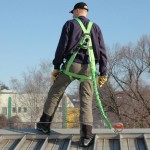 Fall arrest systems are designed as a safety backup mechanism when a worker must be exposed to a fall hazard in order to accomplish assigned tasks. When the worker needs to be able to move along either a horizontal or vertical plane, lifelines are used to protect the worker. The lifelines can be constructed using either cable or fixed-track. Read more.
Fall arrest systems are designed as a safety backup mechanism when a worker must be exposed to a fall hazard in order to accomplish assigned tasks. When the worker needs to be able to move along either a horizontal or vertical plane, lifelines are used to protect the worker. The lifelines can be constructed using either cable or fixed-track. Read more.
April 14, 2014, 11:28 am | by Ray Nardo
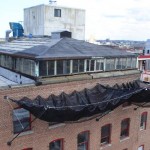 Does your facility feature elevated work areas, unstable walking or working spaces, unprotected edges, floor holes or wall openings?
Does your facility feature elevated work areas, unstable walking or working spaces, unprotected edges, floor holes or wall openings?
If so, there are safety-netting solutions to help ensure your workers – along with pedestrians and nearby structures – are safe from this large variety of fall hazards.
There are, however, places where it’s most important to make sure these solutions are in place: Read more.
April 11, 2014, 2:18 pm | by Ray Nardo
 As a facility manager in charge of worker safety on elevated job sites, it’s important to understand the differences between OSHA regulations and ANSI standards when developing your fall protection program.
As a facility manager in charge of worker safety on elevated job sites, it’s important to understand the differences between OSHA regulations and ANSI standards when developing your fall protection program.
By understanding these differences, you are better able to:
- Avoid stringent fines for non-compliance;
- Reduce fall hazards and related accidents;
- Improve worker safety and productivity; and
- Decrease lofty workers’ compensation claims.
Read more.
March 28, 2014, 2:49 pm | by Ray Nardo
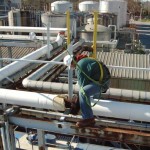 Conducting annual lifeline inspections goes hand in hand with proper training of your workers. Your equipment isn’t protecting anyone when it has missing, worn or defective components. Worse, it can create an unwarranted illusion of security. Installing fall protection equipment in your workplace is a great first step towards keeping your employees working at heights safe from fall hazards. Read more.
Conducting annual lifeline inspections goes hand in hand with proper training of your workers. Your equipment isn’t protecting anyone when it has missing, worn or defective components. Worse, it can create an unwarranted illusion of security. Installing fall protection equipment in your workplace is a great first step towards keeping your employees working at heights safe from fall hazards. Read more.
March 21, 2014, 3:50 pm | by Ray Nardo
 A rescue plan is critical to any well-managed fall protection program, but it is an often-overlooked factor. Having a plan in place is necessary for any organization with workers at height. No one wants to see a co-worker hurt. Every employee working at a height must be prepared to act quickly in the event of an accident, specifically, because suspension trauma starts to set in within minutes. Read more.
A rescue plan is critical to any well-managed fall protection program, but it is an often-overlooked factor. Having a plan in place is necessary for any organization with workers at height. No one wants to see a co-worker hurt. Every employee working at a height must be prepared to act quickly in the event of an accident, specifically, because suspension trauma starts to set in within minutes. Read more.
March 14, 2014, 3:59 pm | by Ray Nardo
 While a comprehensive or strategic fall prevention or protection plan is certainly admirable, advantageous and the right long-term solution, it’s not always practical to implement all at once. The implementation of a complete solution is often a costly and time-consuming undertaking.
While a comprehensive or strategic fall prevention or protection plan is certainly admirable, advantageous and the right long-term solution, it’s not always practical to implement all at once. The implementation of a complete solution is often a costly and time-consuming undertaking.
Do you have to implement a comprehensive solution all at once, or piecemeal the installation? Read more.
 Whether you’re talking about tankers, flatbeds, or open or enclosed trailers, the business of loading and unloading, or servicing large vehicles can present a fall hazard. Working on loading docks, on scaffolding above or beside the trucks, or on the roof or sides of the trucks themselves, workers put themselves at risk in multiple situations where they are in danger of falling. Read more.
Whether you’re talking about tankers, flatbeds, or open or enclosed trailers, the business of loading and unloading, or servicing large vehicles can present a fall hazard. Working on loading docks, on scaffolding above or beside the trucks, or on the roof or sides of the trucks themselves, workers put themselves at risk in multiple situations where they are in danger of falling. Read more.









